Notes from New York: Names, Networks, and Connectors in Art History
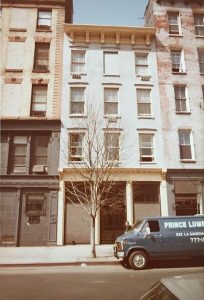
The Renee and Chaim Gross Foundation, located in Greenwich Village, is the historic home and studio of American sculptor Chaim Gross (1904–1991) (fig. 1). The foundation is housed in a four story townhouse, with the artist’s dramatic sculpture studio on the ground floor (fig. 2). Gross built the studio in 1963 when he purchased the building. It was his final workspace after a long history of studios he had in the Village beginning in the 1930s.1 He and his wife Renee rented the second floor, and in the third floor living space, Gross installed a portion of what had grown to be an extensive art collection of over one thousand works by his American and European contemporaries (fig. 3).2 Gross admired artist house museums that he had seen during his travels in Europe after World War II, such as the Delacroix museum in Paris, and it was his dream to have a house museum similar to the European models. He incorporated the foundation as a nonprofit organization in 1989, shortly before his death in 1991.
Today, the foundation is open to the public and it presents a unique perspective of twentieth-century American art, from the artist’s viewpoint.
Gross himself was the curator, deciding which of his own works to retain, and also how to hang those of his contemporaries. His original installation of his own sculpture and art collection has been preserved, and in this way, the space is unmediated by the professional curator or art historian, and has the sense of being a pre-museum, or even a primary source. A key question for the foundation is how, as a unique resource, can the institution contribute to the museum field and also to art history?
What can museums learn from the foundation in the twenty-first century?
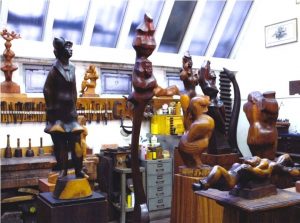
It has been over twenty years since Gross’s wife, Renee Nechin Gross (1910–2005), first opened the foundation to the public in 1994. At that time, the public display at the foundation was limited to Gross’s ground floor studio, plus a new second floor gallery space featuring a survey of the sculptor’s later bronzes, organized by the first curator of the foundation, April Paul (1931–2014). Renee Gross still lived in the third floor living space that held the private art collection (with the bedrooms on the fourth floor above, which are now the foundation offices). At that time, the display at the foundation told the story of Chaim Gross. Then (and now), visitors could immerse themselves in his studio, and even touch the sculptures. They could form a real connection to his work and to twentieth-century sculpture. Today when visitors are brought through the studio, it continues to be a resonant space in which to teach people about Gross’s life and work as a pioneer of direct carving in America. His childhood as the son of a timber merchant in the Carpathian Mountains of the Austro-Hungarian Empire, his emigration to the United States in 1921, and his rise as a major American sculptor in the 1930s are discussed.3 Some of the works on view were included in his earliest solo exhibitions in the thirties in New York City that established his reputation, and were the work of a rising, ambitious artist. The maquettes for his public works, including his important public commissions from the WPA, which also contributed to his increasing fame in the 1930s, are housed in the collection.4
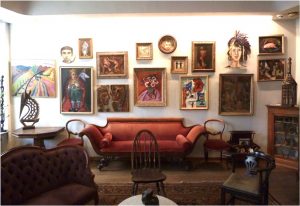
When I came on as director in 2009, four years after the passing of Renee Gross, the third floor living and dining space were opened to the public. It was decided to expand the scholarly focus of the foundation, as well as its audience, to tell the narrative of a single artist in addition to the broader story, or rather multiple stories, about American art and the immigrant artist’s experience in New York City. Today, the space feels alive, twenty-five years after Gross’s death. That may be perhaps because Gross writes his own biography and story through the works on the walls. Visitors are inspired by the strong, discerning eye of a major artist, but they can also continually uncover new connections, networks, and narratives. It is a story that is open, inclusive, and evolving with each new generation of visitors—not a single narrative that is authoritative, closed, and definitive.
These multiple narratives can be traced through the paintings on the walls in the living room. One is Gross’s personal family history, his artistic family tree, told through the works of his daughter, the New York-based artist Mimi Gross (b. 1940), and his former son-in-law Red Grooms (b. 1937), which are interspersed throughout the floor.5
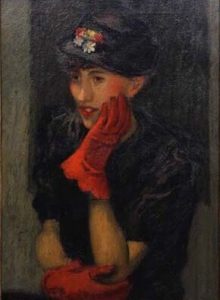
There is a tondo of an infant Mimi by the American realist painter Tully Filmus (1903–1998); another tondo portrait of Mimi in her twenties by Grooms, from the era of their marriage and collaboration on highly experimental films, which were followed by their famous sculptural installations in the early 1970s, including Ruckus Manhattan of 1975. At the far left, there is a 1964 fauvist landscape by Gross; and at the far right, a later portrait of a performer from the early 1980s by Mimi Gross.
There is also the story of Gross’s community of artists at the Educational Alliance art school on the Lower East Side, where he enrolled immediately upon his arrival in the United States in 1921, and first exhibited in 1922. The paintings from the 1930s on this and other walls by Raphael Soyer (1899–1987), Gross’s close lifelong friend from the Alliance, are a vivid presence in the space. Soyer’s Woman with Red Gloves, 1935, is in fact one of fifty-seven works in the collection by Raphael and his twin brother, the painter Moses Soyer (1899—1974) (fig. 4).
Gross went on to teach at the Alliance for over fifty years, and one painting in the collection, The Queen, 1930s, was a gift from his most famous student, Louise Nevelson (1899–1988) (fig. 5). Nevelson painted it in the 1930s before she switched to the sculpture medium. In the foundation archive, there are approximately 1,000 photographs from the twentieth century that document these important communities and connections between artists (fig. 6). The archive is the connector, with documents and materials connecting people; while artists, such as Chaim Gross, are the catalyst.
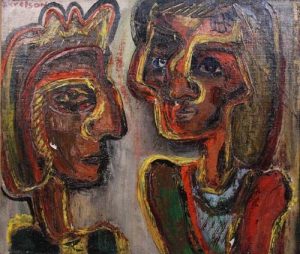
On the same floor, in the dining area, Gross features sculptures by his predecessors and contemporaries, including multiple examples by Aristide Maillol (1861–1944), Gaston Lachaise (1882–1935), and Elie Nadelman (1882–1946), alongside the historic African sculpture that formed a large portion of his collection. Today, the foundation oversees a collection of around 2,000 works of African art. There are also sculptures in this room by artists such as Jose de Creeft (1884–1982), and drawings by William Zorach (1887–1966). They tell the story of Gross’s own development: he was extremely interested in the work of Maillol early in his career; he studied with Nadelman at the Beaux-Arts Institute; and Zorach was his mentor.6 The modern American sculptors from the 1920s to the 1950s defy unification in art historical terms. They are only loosely connected through process, and through the practice of direct carving.7

Another rich resource of the foundation are the books that Chaim Gross owned, which are now part of the 1600 volume library. And, another important resource of great interest are the technical books in Gross’s library that were written by sculptors in the 1930s through the 1950s, including one he authored, The Technique of Wood Sculpture, of 1957. These books came out of the WPA era in response to a greater demand from the public to know about art and how it is made. They were written by artists, and the most ambitious ones, by major figures such as Malvina Hoffman (1887–1966) and Zorach, go far beyond the genre of the technical manual.8 They are also astute reflections on contemporary sculpture, with many references and comparisons to the work of their contemporaries. They are a fresh source, and infuse new ideas and new materials into an understudied area of American art.
Gross’s installation of his art collection extends itself to the viewer, and offers not one, but multiple narratives—about his own life and work, but also about artists working in New York in the twentieth century. The space also tells the story of Jewish life in America, the history of the WPA, and the history of collecting, and particularly, of collecting African and Oceanic sculpture in the early twentieth century. The installation appeals to an intergenerational audience—from young art students to an older generation, including the generation that knew Chaim Gross. It has been an interesting endeavor over the last six years to learn about how the collection is perceived from the different perspectives and viewpoints of foundation visitors. The viewers feel empowered and are able to connect with what relates to them: there is flexibility, and our viewing public therefore helps shape the narrative. It is a different narrative each time, with each visitor.

A few blocks over from the foundation at Bleecker and Eleventh Streets, there is a public sculpture by Chaim Gross titled The Family, 1979, which he gifted to the city of New York in 1991 (fig. 7). Each figure props the other up, and the work is about family and interdependence. Gross’s installation of twentieth-century American art at the foundation is not the voice of authority; instead, it is a proposition, extended generously and in friendship, much like the sculpture of Chaim Gross himself.
DOI: https://doi.org/10.24926/24716839.1562
PDF: Fisher-Notes-From-New-York
Notes
- For a brief history of Gross’s studios in lower Manhattan prior to his purchase of 526 LaGuardia Place in 1963 as recollected by his daughter, artist Mimi Gross, see her recent essay published by the Greenwich Village Society for History Preservation, Judith Stonehill, ed., Greenwich Village Stories: A Collection of Memories (New York: Universe, 2014). ↵
- On Gross’s private collection, see Alma Jones Waterhouse, “The Yeses of Chaim Gross: Art Collecting as Autobiography,” Connoisseur 215 (May 1985): 122–28, with photographs by Benno Friedman; Joseph Jacobs, “Microcosm of Modernism,” Art and Antiques 32 (March 2008): 122–29; and Diana Linden “To Life! To Life! The Renee and Chaim Gross Foundation,” The Magazine Antiques 183 (September 2016): 100–7. ↵
- For an overview of Gross’s life and work written on the occasion of his 1977 retrospective at The Jewish Museum in New York, see the excellent essay by Roberta K. Tarbell, “Chaim Gross,” in Chaim Gross: Retrospective Exhibition, also available online since 2009 through Traditional Fine Arts Organization Inc. at: (link: http://www.tfaoi.com/aa/9aa/9aa176.htm) ↵
- See Roberta K. Tarbell, “Recognition and Government Projects” in ibid. Gross’s 1939 commission for his mahogany relief Puddlers for the post office in Irwin, PA (installed 1942), was included in the exhibition, A Common Canvas: Pennsylvania’s New Deal Post Office Murals, The State Museum of Pennsylvania, Harrisburg, PA, November 22–May 19, 2009. ↵
- For Mimi Gross’s narrative on the legacy of her father Chaim Gross and her own work, see her forthcoming image-essay “Puzzling the Legacy,” Art Journal 76 (forthcoming 2017). ↵
- On Gross’s training in the 1920s after emigrating to the United States, see the Oral History Interview with Chaim Gross (May 26–27, 1981) by Milton Wolf Brown for the Archives of American Art. See also Zorach’s preface to Gross’s first solo show in Exhibition of Sculpture by Chaim Gross (New York: Gallery 144, 1932). ↵
- The practice of direct carving is currently the subject of a recent reinstallation presented on the first floor at the Smithsonian American Art Museum by curator Karen Lemmey. There are twenty-four works from the extensive sculpture holdings of the Smithsonian American Art Museum on view indefinitely. On direct carving in America, see also Judith Zilczer, “The Theory of Direct Carving in Modern Sculpture,” Oxford Art Journal 4, no. 2 (November 1981): 44–49. ↵
- See Malvina Hoffman, Sculpture Inside and Out (New York: Bonanza Books, 1939) and William Zorach, Zorach Explains Sculpture (New York: American Artists Group, 1947). ↵
About the Author(s): Susan Greenberg Fisher is Executive Director of The Renee and Chaim Gross Foundation, New York.

